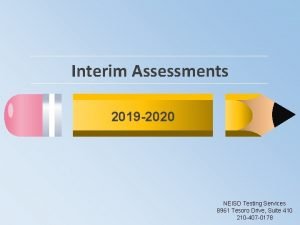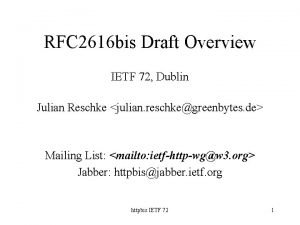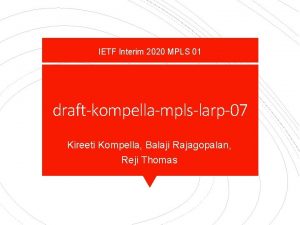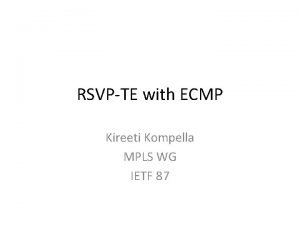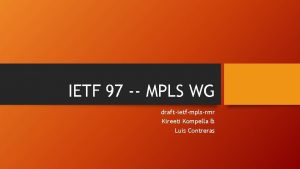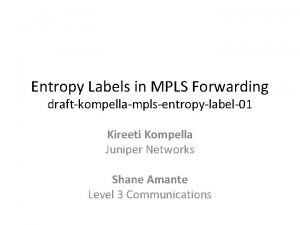IETF Interim 2020 MPLS 01 draftkompellamplslarp07 Kireeti Kompella







- Slides: 7

IETF Interim 2020 MPLS 01 draft-kompella-mpls-larp-07 Kireeti Kompella, Balaji Rajagopalan, Reji Thomas

Use Cases for L-ARP MPLS in the data center MPLS in the access L-ARP client is a compute server participating in an MPLS underlay L-ARP client is a D-SLAM/OLT/… with a label per subscriber L-ARP server is a Top-of-Rack switch L-ARP server is a BNG device

WHAT’S CHANGED? § This work was done 5 -6 years ago § At the time, there was some interest from some niche corners for an MPLS underlay in data centers § But most data centers and caching Po. Ps were using an MPLS overlay over an IP (GRE or UDP) underlay § Lately, there’s a resurgence of interest in an MPLS underlay in DCs, from the server, possibly using SPRING § While it’s common to run BGP or some form of an overlay SDN controller to the server, it’s not usual to run an IGP or LDP on the server § So, what will the control plane for the MPLS underlay be?

RECAP ON HOW L-ARP WORKS Similar to “regular” ARP: § ARP client asks ARP server for a MAC address (hw type Ethernet) to reach an IPv 4 address (protocol type IPv 4) § L-ARP client X asks L-ARP server T 1 for a label (hw type MPLS) to reach an IPv 4 address Y (protocol type IPv 4) § L-ARP server T replies with a label L 1 § L-ARP server advertises L-ARP client’s IP address to rest of MPLS network

HOW L-ARP WORKS Y 1 T 2 T 1 X T 3 4 1. 2. 3. 4. 5. X asks T 1 for a label to Y T 1 checks LFIB for entry to Y, say it gets label L 2 T 1 allocates label L 1, inserts LFIB entry L 1 L 2 T 1 sends an L-ARP reply of L 1 to X (*) T 1 advertises [X, L 3] to rest of MPLS network Z

HOW L-ARP WORKS: notes Note that X and Y don’t have to be in the same subnet. T 1 is effectively implementing proxy ARP on behalf of Y 1. 2. 3. 4. 5. Why does X ask for a label to Y? Use case: X and Y have VMs or containers in the same VRF. X gets a BGP advert with next hop Y and wants an MPLS tunnel to Y X asks T 1 for a label to Y T 1 checks LFIB for entry to Y, say it gets label L 2 T 1 allocates label L 1, inserts LFIB entry L 1 L 2 T 1 sends an L-ARP reply of L 1 to X (*) T 1 advertises [X, L 3] to rest of MPLS network How does T 1 advertise [X, L 3]? This is a “proxy” advertisement on behalf of X; how it’s done depends on the protocol used What if the entry L 2 is a label stack (a la SPRING)? T 1 effectively creates a “binding SID” L 1 for Y and sends this to X

NEXT STEPS § Quite a bit of work was done on this, but quite a while ago § This included a prototype implementation on Linux and on a To. R running Junos § Need to refresh much of that work § Linux MPLS code has changed significantly § Some protocol details need to be ironed out § § Format: label(s), metric, ELC, … Multihomed servers (L-ARP clients) L-ARP in SPRING networks Restart and persistence of label allocation




